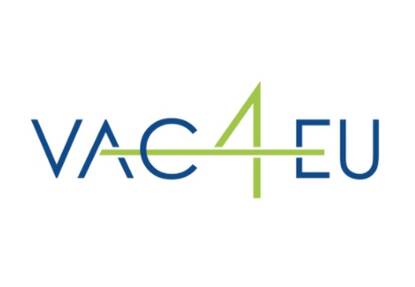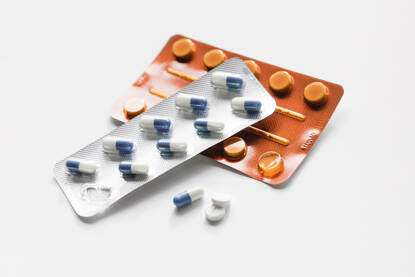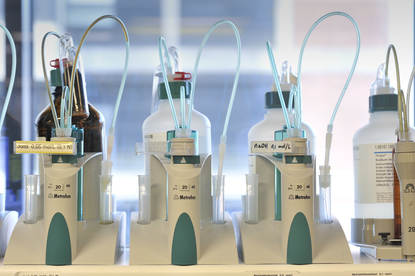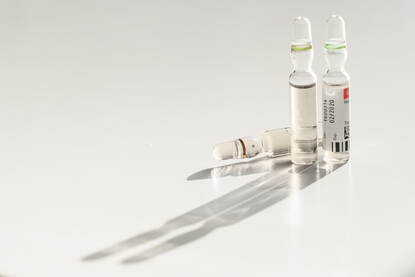COVID-19 vaccine development is moving at full speed. Monitoring the benefits and safety following marketing authorisation of a vaccine might prove a challenge, given the large scale of deployment needed. The ACCESS initiative aims to prepare Europe for reliable and efficient monitoring. Professor Miriam Sturkenboom of the University Medical Center Utrecht is one of the programme leads.
ACCESS (vACcine Covid-19 monitoring ReadinESS) is intended to prepare Europe and to activate the infrastructure needed to monitor benefits, coverage and safety risks of new COVID-19 vaccines in the post-authorisation stage.
To be able to accurately monitor side effects and coverage of vaccines on a continental scale, an enormous batch of data needs to be monitored. Data and information are the things that make Miriam Sturkenboom’s eyes sparkle. “The steps that help us move from data to information: that is what interests me. The same goes for real world data from medicines and medical treatments, which have to be translated into real world information”, Miriam explains. “But we shouldn’t forget the next step: making that information available and useful for healthcare professionals in a timely manner. That is what completes the cycle. It starts with healthcare professionals posing questions, which in turn may generate data leading to information that can answer those questions. That information should get back to the professional as soon as possible.”
And that last part, ‘as soon as possible’, is definitely at play in the current COVID-19 situation. The world is awaiting a vaccine against the corona virus. Miriam: “As a consequence, clinical trial phases are conducted in a parallel fashion, creating high throughput in shorter time, whilst the requirements and safety standards remain unchanged.”
That creates a challenge. “Many challenges are similar to those in normal processes, but particularly in this situation follow-up in pivotal trials may be limited, which does not allow us to draw conclusions on long term effects”, Miriam continues. “The number of included patients is too low to be able to predict rare side effects. Also, effects on specific subpopulations, like the elderly, pregnant women or people with a weak immune system, are hard to predict. In vaccine studies, this is a problem, since vaccines will be administered especially in these subpopulations. Vulnerable populations, who most of the time aren’t well represented in clinical pre-marketing trials. That makes monitoring in the post-marketing phase very important. You simply can’t know everything upfront.”

ACCESS
That is where the ACCESS programme steps in. To understand the size and scale of the programme, we need to go back to 2009. The Mexican flu pandemic entered the stage. Learning from that situation, the European Medicines Agency (EMA) decided Europe had to be more prepared for future situations. “They learned that more international collaboration was needed, with shorter and more diverse communication lines between vaccine developers and regulatory bodies. The EMA concluded that the full potential was not used and therefore, in 2019, issued a development proposal at the Innovative Medicines Initiative (IMI). IMI is a public-private partnership aiming to speed up the development of better and safer medicines for patients. The proposal hinted at the development of a European collaborative system for monitoring of vaccines.”
The proposal subsequently led to the IMI-ADVANCE project, which had the aim of developing a blueprint for that system. Miriam coordinated the project. “It was established to develop and test methods, procedures and guidelines to generate a reliable set of data to assess benefits and risks of vaccines, in the post-marketing phase. Based on this data, regulators and authorities should be able to make better decisions on safety, efficacy and strategy and to maintain societal confidence in immunisation. In ADVANCE, we brought together the European Centre for Disease Prevention and Control (ECDC) and the EMA, national public health and regulatory bodies, vaccine manufacturers and academic groups.”
In the ADVANCE project a system was designed and tested, a code of conduct written and a complete blueprint of the infrastructure for monitoring was drawn up. Just in time, so it turned out. “We finished the project early 2020 and handed over the tools to VAC4EU, an international not-for-profit organisation setup to implement the ADVANCE blueprint. VAC4EU is an international association with a large network that can run studies and an open community for scientific collaboration and discussion.”
Interview continues underneath the picture -->


Getting VAC4EU ready
This year has been focused on getting VAC4EU ready for action amidst the COVID-19 pandemic. That is the job at hand for ACCESS (vACcine Covid-19 monitoring ReadinESS), led by Miriam and her colleague from Utrecht University, prof. dr. Olaf Klungel. In the ACCESS-project, 22 organisations work together to prepare Europe to monitor the benefits and safety of the new vaccines.
ACCESS follows the current development stages. Miriam: “Several vaccines are currently in various stages of development. To be able to asses and compare their efficacy and safety, it is important to collect data and make it available in an uniform way. Only then it is possible to monitor the vaccines across borders, formats and platforms. It all starts with raw data. Different European countries have different ways of organising healthcare. That leads to different ways of data collection and database build-up. The key is to get all this data into the same template, to make large scale comparison and analysis possible.”
Based on the ADVANCE testing, VAC4EU has the tools to do so, Miriam explains. “The trick is to keep the data local. We bring the analysis to the data, instead of the other way around. There is a common data model, a uniform template that can be used. Scripts and functions are generated and shared with the countries. They run the scripts locally and send the edited data back to the central server. This concept has been proven to work in the ADVANCE-project.”
ACCESS now focuses on 3 target areas. “In the first place it is about setting up the infrastructure ánd recruiting countries to participate in the monitoring. Second, we need to establish protocols and working procedures and third, ACCESS aims to set up protocol templates in the field of safety, efficacy, coverage and uptake.”
Transforming ADVANCE 1-to-1 to the new situation is not possible. “The ADVANCE project was based only on secondary use of electronic healthcare data. That might be an issue in the current COVID-19 situation, since in several mainly eastern European countries, that type of data simply isn’t available. Therefore, we now focus on three different pathways for collecting (safety) data. Besides electronic healthcare data, we focus on hospital data as well as app-based data, collecting side effects through patient input. This means every country in Europe is able to participate. Standard protocols will be in place to harmonize and reduce the differences in all hospital and electronic data, so all data can be treated equally in the analysis phase.”
And data analysis has already started. “We have defined 38 different ‘adverse events of special interest’. Those are predefined events which might occur as side effects. We are already collecting data to set background rates for these events. Knowing the incidence rates that occur without vaccination will help us assess the impact of safety signals in the monitoring phase. Then we will be able to compare what we observe with what we expect.”
The importance of large scale monitoring was clearly demonstrated in the aftermath of the Mexican flue. “A lesson we learned there is to expect the unexpected”, Miriam adds. “The systems in place were looking at a range of effects. Narcolepsy was not expected, as it had never been associated with vaccines before. It underscores we can be prepared but need to be ready to address unexpected issues as well at large scale. ACCESS is preparing for this.”
Within VAC4EU, the blueprint is in good hands, Miriam believes. “VAC4EU has proven its usefulness and has a valuable network of members. It can handle a large capacity of work, without creating a large organisation. The network operates as a matchmaker and provides the infrastructure, the member organizations run the studies.” VAC4EU also has an open community, which makes it possible for everyone to connect and discuss on scientific topics, it organizes webinars and task forces around certain topics.
Currently, ACCESS moves full speed ahead. “The protocols for background rate monitoring and the exact definitions of all the adverse events have been finalised. Other protocols are also practically ready to be shared. The generation of background rates has also started. Health data on about 130 million patients in 7 countries are being monitored, to generate background rates.”
“In order to recruit more EU member states to increase the scale, a campaign started to explore the interest of other countries to participate as well. ACCESS is a great example of taking quick action and of harnessing the power of coordinated international collaboration. The plan is to have everything ready mid-December, although everything that is ready beforehand will be released before that date. And then we’re ready for implementation. I really hope this will be a joint effort as well.”
COVID-19 will show if this way of large scale vaccine monitoring works. Miriam is hopeful. “The framework is there, the spirit is there and collaboration in the VAC4EU network is running smooth, so the preconditions are fine. Let’s hope this will help the vaccination move forward – and fight COVID-19 back.”

'A need for more follow up data on vaccines'
“As with all medicines, strong evidence from clinical trials on the safety, efficacy and the quality is also needed for COVID-19 vaccines. It is well known that clinical trials however provide limited information, for example on longer term follow up, special populations and rare adverse reactions”, says Sabine Straus, chair of the Pharmacovigilance Risk Assessment Committee (PRAC) of the European Medicines Agency.
“Once on the market, approved vaccines will therefore need to be monitored closely using all available pharmacovigilance tools, like for example spontaneous adverse events as reported by patients and healthcare professionals. In addition there is also a need for other pharmacovigilance activities like the new infrastructure, which is put in place by this initiative, to provide further follow up data on all vaccines. This infrastructure will provide additional information from real world and actual clinical practice and the data generated will complement the data collected from pre-authorisation and post authorization.”
“A Europe-wide network of data sources including health insurance records, general practitioner and hospital health records will be used by the researchers to monitor coverage and safety of COVID-19 vaccines and will provide further data on possible adverse events of special interest that might need extra consideration for these COVID-19 vaccines.”






